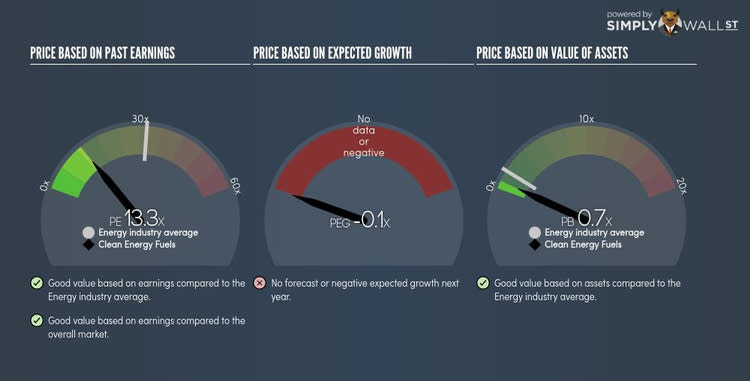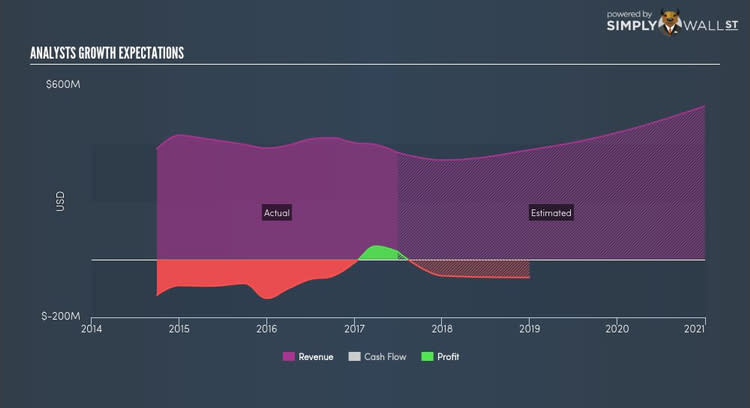Should You Be Tempted To Buy Clean Energy Fuels Corp (CLNE) Because Of Its PE Ratio?

Clean Energy Fuels Corp (NASDAQ:CLNE) trades with a trailing P/E of 13.3x, which is lower than the industry average of 31.6x. While CLNE might seem like an attractive stock to buy, it is important to understand the assumptions behind the P/E ratio before you make any investment decisions. In this article, I will deconstruct the P/E ratio and highlight what you need to be careful of when using the P/E ratio. View our latest analysis for Clean Energy Fuels
Breaking down the Price-Earnings ratio
The P/E ratio is one of many ratios used in relative valuation. It compares a stock’s price per share to the stock’s earnings per share. A more intuitive way of understanding the P/E ratio is to think of it as how much investors are paying for each dollar of the company’s earnings.
Formula
Price-Earnings Ratio = Price per share ÷ Earnings per share
P/E Calculation for CLNE
Price per share = 2.49
Earnings per share = 0.188
∴ Price-Earnings Ratio = 2.49 ÷ 0.188 = 13.3x
The P/E ratio itself doesn’t tell you a lot; however, it becomes very insightful when you compare it with other similar companies. Ultimately, our goal is to compare the stock’s P/E ratio to the average of companies that have similar attributes to CLNE, such as company lifetime and products sold. A common peer group is companies that exist in the same industry, which is what I use below. Since it is expected that similar companies have similar P/E ratios, we can come to some conclusions about the stock if the ratios are different.
CLNE’s P/E of 13.3x is lower than its industry peers (31.6x), which implies that each dollar of CLNE’s earnings is being undervalued by investors. Therefore, according to this analysis, CLNE is an under-priced stock.
Assumptions to watch out for
However, before you rush out to buy CLNE, it is important to note that this conclusion is based on two key assumptions. The first is that our “similar companies” are actually similar to CLNE. If the companies aren’t similar, the difference in P/E might be a result of other factors. For example, if you inadvertently compared lower risk firms with CLNE, then investors would naturally value CLNE at a lower price since it is a riskier investment. Similarly, if you accidentally compared higher growth firms with CLNE, investors would also value CLNE at a lower price since it is a lower growth investment. Both scenarios would explain why CLNE has a lower P/E ratio than its peers. The second assumption that must hold true is that the stocks we are comparing CLNE to are fairly valued by the market. If this does not hold, there is a possibility that CLNE’s P/E is lower because firms in our peer group are being overvalued by the market.
What this means for you:
Are you a shareholder? You may have already conducted fundamental analysis on the stock as a shareholder, so its current undervaluation could signal a good buying opportunity to increase your exposure to CLNE. Now that you understand the ins and outs of the PE metric, you should know to bear in mind its limitations before you make an investment decision.
Are you a potential investor? If you are considering investing in CLNE, basing your decision on the PE metric at one point in time is certainly not sufficient. I recommend you do additional analysis by looking at its intrinsic valuation and using other relative valuation ratios like PEG or EV/EBITDA.
PE is one aspect of your portfolio construction to consider when holding or entering into a stock. But it is certainly not the only factor. Take a look at our most recent infographic report on Clean Energy Fuels for a more in-depth analysis of the stock to help you make a well-informed investment decision. Since we know a limitation of PE is it doesn't properly account for growth, you can use our free platform to see my list of stocks with a high growth potential and see if their PE is still reasonable.
To help readers see pass the short term volatility of the financial market, we aim to bring you a long-term focused research analysis purely driven by fundamental data. Note that our analysis does not factor in the latest price sensitive company announcements.
The author is an independent contributor and at the time of publication had no position in the stocks mentioned.

 Yahoo Finance
Yahoo Finance 

